

Videos and Worksheets. 2D shapes: names Video 1 Practice Questions Textbook Exercise 2D shapes: quadrilaterals Video 2 Practice Questions Textbook Exercise 3D shapes: names Video 3 Practice Questions Textbook Exercise 3D shapes: nets Video 4 Practice Questions Textbook Exercise 3D shapes: vertices, edges, faces Video 5 Practice Questions Textbook Exercise Addition: column method Video 6 Practice Questions Textbook Exercise Algebra: changing the subject Video 7 Practice Questions Textbook Exercise Algebra: changing the subject advanced Video 8 Practice Questions Textbook Exercise Algebra: collecting like terms Video 9 Practice Questions Textbook Exercise Algebra: completing the square Video 10 Practice Questions Textbook Exercise.
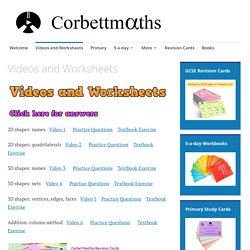
MyMoneyWeek. Aa A-Level Advanced Level qualifications are available for 16-18-year-olds in various subjects that help students make a successful transition to university and future careers.
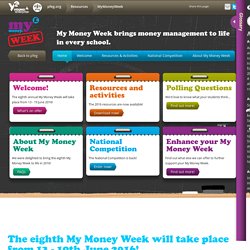
Reforms introduced in 2015 and phased in over 3 years, will see A levels becoming linear in nature with all external assessment at the end of the course – normally by examination. Academies Schools that have converted from formally local authority schools to become directly accountable to the Secretary of State for Education. Accidental damage In addition to buildings and contents insurance most companies will insure accidental damage for an additional fee. Accommodation Where you live; including with parents, in a hostel, renting or buying.
TES Maths: Top 12 investigations. Engaging investigation ideas to inspire creative thinking in your classroom Since the abolition of maths coursework, there is no formal requirement to carry out investigations with your students.
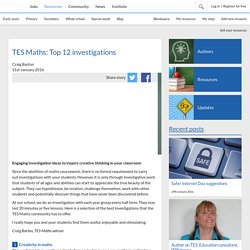
However, it is only through investigative work that students of all ages and abilities can start to appreciate the true beauty of the subject. They can hypothesise, be creative, challenge themselves, work with other students and potentially discover things that have never been discovered before. At our school, we do an investigation with each year group every half term. They may last 20 minutes or five lessons. I really hope you and your students find them useful, enjoyable and stimulating. Untitled. New English and maths resources. Public Last updated: 19th Mar 2015 Introduction to the project From late 2014 to early 2015, AELP led a DfE-funded project with four FE-sector provider organisations to develop resources for delivering English GCSEs.
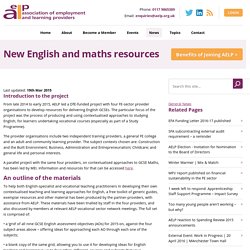
The particular focus of the project was the process of producing and using contextualised approaches to studying English, for learners undertaking vocational courses (especially as part of a Study Programme). The provider organisations include two independent training providers, a general FE college and an adult and community learning provider. A parallel project with the same four providers, on contextualised approaches to GCSE Maths, has been led by MEI. An outline of the materials To help both English-specialist and vocational teaching practitioners in developing their own contextualised teaching and learning approaches for English, a free toolkit of generic guides, exemplar resources and other material has been produced by the partner-providers, with assistance from AELP.
Give Your Brain A Workout!
FS Mathematics OCR Activity Bank E1 L2. FS: Maths 4 Life - Resources & learning Sessions. Using a calculator. Excellence Gateway Materials E1. Excellence Gateway Materials E2. Excellence Gateway Materials E3. Excellence Gateway Material L1 maths. Excellence Gateway Materials Maths L2. Online resources. Maths in context (embedding) How to sheets for maths. Scales and tolerances. Ratio and proportion. Shape and Space: area and volume. Graphs and charts. Maths apps. Scale drawings. Bar modelling- a powerful visual approach for introducing number topics. Building on my recent post about a taxonomy for deep learning in maths, I have been trying to think a bit deeper myself about what each type of ‘deep learning link’ might look like.
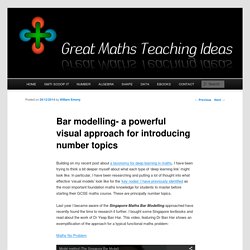
In particular, I have been researching and putting a lot of thought into what effective ‘visual models’ look like for the ‘key nodes’ I have previously identified as the most important foundation maths knowledge for students to master before starting their GCSE maths course. These are principally number topics. Last year I became aware of the Singapore Maths Bar Modelling approached have recently found the time to research it further.
I bought some Singapore textbooks and read about the work of Dr Yeap Ban Har. This video, featuring Dr Ban Har shows an exemplification of the approach for a typical functional maths problem: Maths No Problem In primary education in Singapore, maths teachers follow a Concrete-Pictorial-Abstract (CPA) sequence when teaching maths topics. Next up, equivalent fractions: